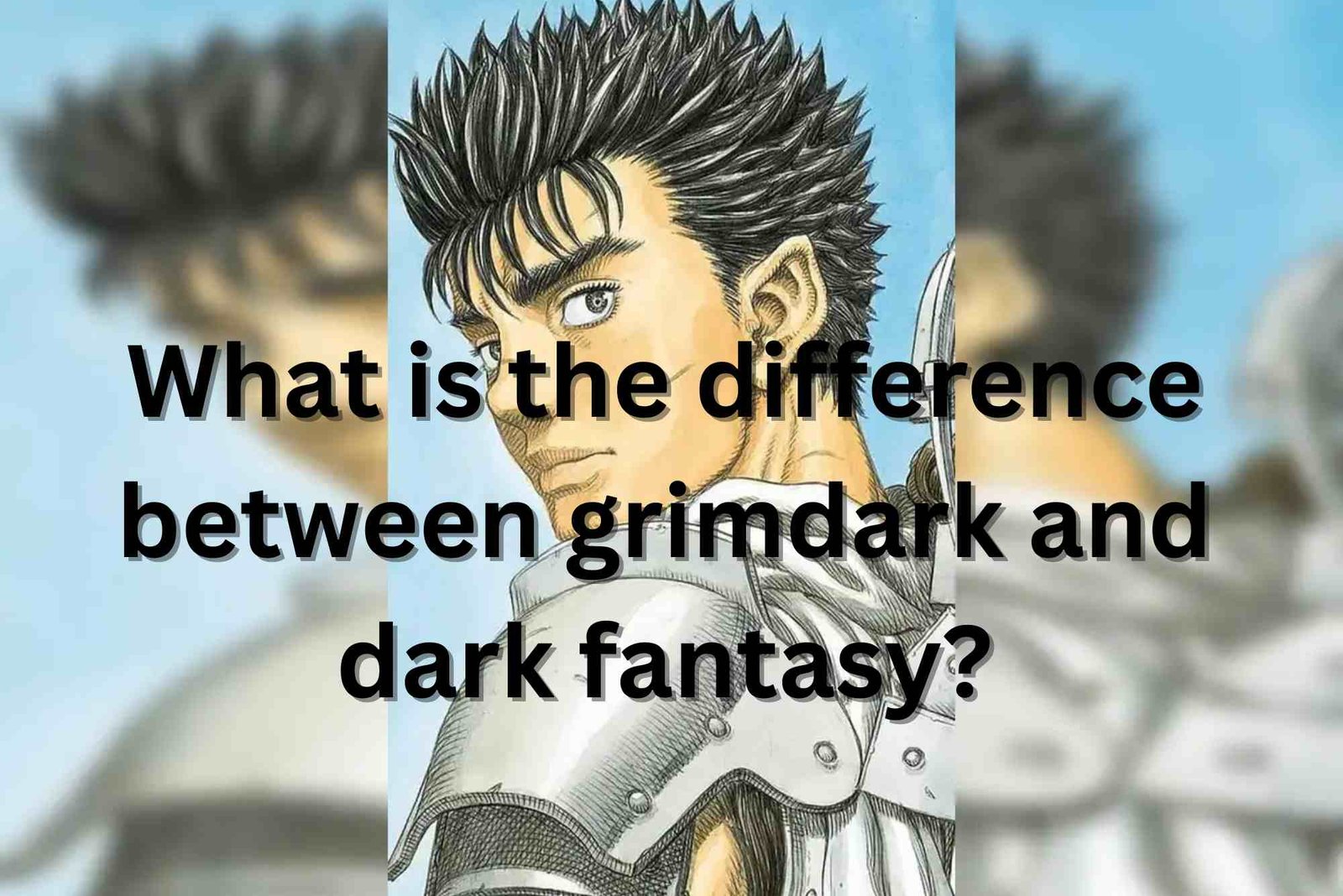Fantasy literature has always captivated readers with its ability to transport us to worlds filled with magic, mythical creatures, and epic battles. Among the many subgenres, grimdark and dark fantasy stand out for their intense, often unsettling narratives. While these terms are sometimes used interchangeably, they represent distinct approaches to storytelling. In this article, we’ll explore the differences between grimdark and dark fantasy, diving into their origins, characteristics, and notable examples like Berserk by Kentaro Miura. By the end, you’ll have a clear understanding of what sets these subgenres apart and why they resonate with fans.
Understanding Dark Fantasy
What Defines Dark Fantasy?
Dark fantasy is a subgenre of fantasy that blends traditional fantasy elements—such as magic, mythical creatures, and epic quests—with darker, often horrific themes. It explores the shadowy corners of human nature, incorporating elements of horror, tragedy, and moral ambiguity. Unlike high fantasy, which often emphasizes heroism and clear distinctions between good and evil, dark fantasy thrives on complexity, where heroes may have flaws, and villains might evoke sympathy.
Dark fantasy stories often feature supernatural elements, such as demons, undead creatures, or malevolent gods, creating an atmosphere of dread. The tone is somber, and the stakes feel personal, often focusing on characters grappling with inner demons as much as external threats. A prime example is Berserk, the iconic manga by Kentaro Miura, which follows Guts, a lone warrior battling both physical and psychological horrors in a world teeming with demonic forces.
Key Characteristics of Dark Fantasy
-
Horror Elements: Dark fantasy often incorporates horror, such as grotesque creatures or psychological torment. In Berserk, Kentaro Miura masterfully weaves visceral horror into the narrative, with scenes of monstrous apostles and graphic violence.
-
Moral Ambiguity: Characters in dark fantasy rarely fit neatly into “hero” or “villain” categories. They make tough choices, sometimes driven by desperation or survival.
-
Supernatural Threats: Magic in dark fantasy often has a sinister edge, with curses, necromancy, or demonic pacts playing a central role.
-
Emotional Depth: The subgenre delves into themes of loss, betrayal, and existential dread, creating stories that linger with readers.
Notable Examples of Dark Fantasy
Beyond Berserk, other works exemplify dark fantasy’s appeal. George R.R. Martin’s A Song of Ice and Fire series blends political intrigue with supernatural threats, like the White Walkers, creating a world where no one is safe. Similarly, Clive Barker’s The Books of Blood merges horror and fantasy, exploring the macabre through vivid storytelling. These works share dark fantasy’s focus on blending the fantastical with the unsettling, often leaving readers questioning morality and fate.
Exploring Grimdark Fantasy
What is Grimdark?
Grimdark is a subgenre of fantasy characterized by its unrelentingly bleak tone, morally gray characters, and a world where hope is scarce. The term “grimdark” originated as a tongue-in-cheek reference to the tagline of the Warhammer 40,000 universe: “In the grim darkness of the far future, there is only war.” This phrase captures the essence of grimdark—a world where cynicism, violence, and despair dominate, and traditional notions of heroism are often subverted.
In grimdark stories, the world itself is a harsh, unforgiving place. Characters are flawed, driven by selfish motives or survival instincts, and “happy endings” are rare. While dark fantasy incorporates horror, grimdark leans heavily into nihilism, questioning whether good can ever truly triumph. Kentaro Miura’s Berserk is often cited as a grimdark work due to its brutal depiction of a world where betrayal and suffering are constants, and Guts’ relentless struggle feels Sisyphean at times.
Key Characteristics of Grimdark
-
Cynical Worldview: Grimdark settings are often dystopian, with corruption, betrayal, and violence as the norm. The world of Berserk exemplifies this, with its endless wars and demonic overlords.
-
Morally Gray Characters: Heroes in grimdark are rarely pure; they may commit atrocities to survive or achieve their goals. Villains, meanwhile, might have understandable motivations.
-
Realism in Fantasy: Despite fantastical elements, grimdark grounds its stories in gritty realism, focusing on the harsh realities of war, politics, and human nature.
-
Low Hope Quotient: While dark fantasy may offer glimmers of hope, grimdark often leaves readers with a sense of futility, where victories come at a steep cost.
Notable Examples of Grimdark
Grimdark has gained popularity through works like Joe Abercrombie’s The First Law trilogy, which features morally compromised characters navigating a brutal world. Mark Lawrence’s Broken Empire series, with its ruthless protagonist Jorg Ancrath, also embodies grimdark’s unflinching approach to violence and power. These stories, like Berserk, showcase a world where survival often demands sacrificing one’s humanity.
Comparing Grimdark and Dark Fantasy
Tone and Atmosphere
The most significant difference between grimdark and dark fantasy lies in their tone. Dark fantasy is dark but not necessarily hopeless; it balances horror and fantasy with moments of redemption or resilience. Grimdark, however, embraces a more nihilistic perspective, where hope is fleeting, and outcomes are often bleak. In Berserk, Kentaro Miura blends both subgenres, with dark fantasy elements like demonic creatures and grimdark’s relentless despair, as Guts faces an unending cycle of suffering.
Character Morality
In dark fantasy, characters may be flawed, but they often retain some redeeming qualities or strive for a greater good. Grimdark characters, by contrast, are deeply flawed, often acting out of self-interest or desperation. For example, in dark fantasy, a character might sacrifice themselves for others, while in grimdark, they might betray allies to survive. Guts in Berserk straddles this line—his rage and trauma drive him, yet his loyalty to a few key characters adds a layer of complexity.
Worldbuilding
Dark fantasy worlds often feature supernatural or gothic elements, creating an eerie atmosphere. Grimdark worlds, while fantastical, emphasize gritty realism, with detailed depictions of war, politics, and societal decay. Both subgenres can overlap, as seen in Berserk, where Kentaro Miura crafts a world of medieval brutality alongside demonic horrors.
Narrative Focus
Dark fantasy often explores personal struggles and supernatural threats, with a focus on emotional or psychological depth. Grimdark, meanwhile, emphasizes systemic issues—corrupt institutions, endless wars, or societal collapse. While dark fantasy might focus on a hero’s inner battle, grimdark highlights the futility of fighting against a broken world.
Why Do These Subgenres Resonate with Readers?
The Appeal of Dark Fantasy
Dark fantasy appeals to readers who enjoy exploring the darker side of human nature within a fantastical framework. It offers a cathartic experience, allowing readers to confront fears of mortality, betrayal, or the unknown through a safe, fictional lens. Works like Berserk draw readers in with their emotional depth and complex characters, making the horrors feel personal and relatable.
The Allure of Grimdark
Grimdark resonates with those who appreciate unflinching realism in their fantasy. Its cynical take on power, morality, and survival mirrors real-world complexities, making it compelling for readers who want stories that challenge idealism. The grimdark elements in Berserk, such as Guts’ relentless struggle against insurmountable odds, tap into a fascination with resilience in the face of despair.
How Berserk Bridges Both Subgenres
Kentaro Miura’s Berserk is a masterclass in blending dark fantasy and grimdark. The manga’s dark fantasy roots are evident in its supernatural elements—demonic apostles, cursed artifacts, and otherworldly realms. Yet, its grimdark sensibilities shine through in the unrelenting brutality of its world, where betrayal and loss are constants. Guts, the protagonist, embodies both subgenres: his battles against demons align with dark fantasy, while his morally complex journey and the bleakness of his world scream grimdark.
Miura’s storytelling, with its intricate art and layered characters, elevates Berserk as a standout in both subgenres. The manga’s exploration of trauma, sacrifice, and vengeance resonates with fans, making it a touchstone for discussions about grimdark and dark fantasy.
Choosing Between Grimdark and Dark Fantasy
For readers new to these subgenres, choosing between grimdark and dark fantasy depends on preference. If you enjoy horror-infused stories with emotional depth and supernatural elements, dark fantasy might be your preference. If you’re drawn to gritty, cynical tales where morality is blurred and hope is scarce, grimdark will likely appeal more. Many works, like Berserk, offer a mix of both, satisfying fans of complex, dark narratives.
Conclusion
Grimdark and dark fantasy, while sharing some similarities, offer distinct experiences for readers. Dark fantasy captivates with its blend of horror and fantasy, exploring moral ambiguity and supernatural threats. Grimdark, on the other hand, dives into cynicism and realism, presenting worlds where hope is a luxury. Kentaro Miura’s Berserk masterfully bridges these subgenres, delivering a story that’s both hauntingly supernatural and unrelentingly bleak. Whether you’re drawn to the emotional depth of dark fantasy or the gritty realism of grimdark, both subgenres offer rich, thought-provoking stories that linger long after the final page.






